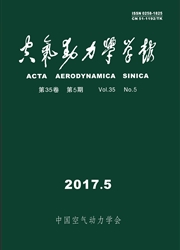

 中文摘要:
中文摘要:
MF -1是我国首次以高超声速空气动力学基础问题研究为目的的航天模型飞行试验, 试验模型为锥-柱-裙 体 , 主要研究0°攻角圆锥边界层转捩和压缩拐角激波/边界层干扰现象.试验飞行器的结构与热防护系统, 既要满 足飞行安全的基本要求, 又要满足转捩研究对表面精度的特殊要求.针对超大尾翼的变形控制要求, 将字形 加强筋结构优化为“米”字形,有效抑制了尾翼的最大变形量和颤振的发生;针对4片尾翼安装偏角的控制要求,通 过尾翼安装面工艺改进和安装偏角正负抵消的办法, 确保了总安装偏角( 代数和) 小于 7', 有效抑制了弹体滚转; 针 对表面精度控制要求,提出弹体结构/薄壁测温模块-体化设计与二次精加工方案,有效抑制了测温模块对边界层 流动的干扰.地面测温组件热振联合试验、尾翼/尾段静力试验和试验模型振动试验结果表明,MF - 1模型飞行试 验结构与热防护系统安全可靠.飞行试验结果表明,MF - 1模型飞行器结构与热防护关键问题的解决措施基本成 功,但试验模型头锥与前舱连接同轴度偏差导致部分子午线出现台阶超差,从而诱导了部分子午面出现强制转捩 现象, 凸显了表面精度控制对边界层转捩研究的重要性.
 英文摘要:
英文摘要:
The f irst aerospace modeling flight test named M F -1 in China was carried out aiming at studying fundamental problems in hypersonic aerodynamics. By employing a cone- cylinder-flare configuration in the payload modules,the main objective of this test is toinvestigate the boundary layer transition on the cone surface and the shock wave/boundary layer interaction at the compression corner. The structure and thermal protection system ofexperimental vehicle need to satisfy not only the basic requirements of f l ig h t safety, but also the special surface precision requirements regarding transition studies. According to the deformation control requirements of the ta i l f in , the cruciform strengthening structure was optimized to the shape of British 4 Union Jack? , which effectively suppressed the maximum deformation and flutter of the tai l f in . To satisfy the control requirements of the installation deflection of fourtailfins , an improved method fo r the ta i l f in installation and positive and negative offset fo r the deflection installation were used to ensure the total installation deflection less than 7 and effective suppression of the projectile ro l l in g . The integrated design of s tru c tu re / th in wall temperature measurement module and a second precision machining scheme were proposed fo r the requirement of surface precision control. These methods effectively inh ibit the interference of the temperature measurement module on the boundary layer f lo w . Thermal-vibrational joint test of the ground temperature measurement component, tai l/tail- fin static test, and model vibrat ion test show that the structure and thermal protection system for the MF -1 reliable. Fl ight test results show that the structure and thermal protection of the MF -1 basically successfully resolve the key issues. However,the coaxality differences between the nose cone and the front cabin of test model lead to ou--o--tolerance in
 同期刊论文项目
同期刊论文项目
 同项目期刊论文
同项目期刊论文
 期刊信息
期刊信息
